Search: Junior 3 V 2 1

Junior - 3 v 2 1
 0:23
0:23
Junior - 2 v 1 2
Junior - 2 v 1 2
 0:25
0:25
Junior - 2 v 1 1
Junior - 2 v 1 1
To watch over 2500+ videos join now for free!
JOIN NOW 0:15
0:15
Women's - 2 v 3 1
Women's - 2 v 3 1
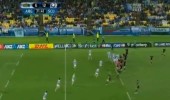 0:19
0:19
Men's - 3 v 2 1
A passage of play that shows how to attack with more attackers than defenders, a 3 v 2. The winger shows that strong running and determination can break tackles. Click on the practises in this section for coaching ideas

Junior - 3 v 2 2
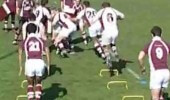 0:21
0:21
6 v 2 v 2 v 2 v 3
Developing the skills into decision making down a channel
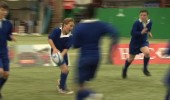 0:26
0:26
3 v 2 in Channel
A development of the 2 v 1 and 3 v1 drills, the attackers now must beat 2 defenders. This requires more decision-making ability as the movements of the defenders could change every time. Players must communicate as well as continue to perform their handling and running skills.
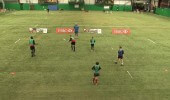 0:28
0:28
3 v 1 in Channel
A progression from the 2 v 1, where a second pass is encouraged to move the ball away from the defender.
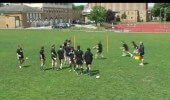 0:33
0:33
3 v 2 in channel
A good progression from the 2 v 1 drill
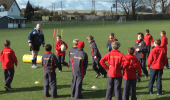 2:15
2:15
Passing - 3 v 2 Live Defenders
Gradually progress from 2 static defenders, to 3 v 2 roaming defenders. The first two players must draw their defenders before giving the pass.
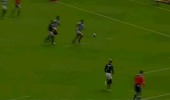
Sevens - 2 v 1
Seven's is about creating chances and then taking them. In this clip the Blue team take the ball up the middle of the pitch to draw in defenders, after recycling the ball they have a 2 v 1 opportunity, a straight line of running and a flat wide pass creates the try. Key factors : Call early - Run straight - Wide spin pass - Catch and swerve to score
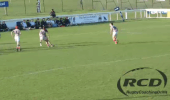
Sevens - 2 v 1
Having identified a 2 v 1 situation, the RGS Guildford player decides not to give an early pass from the breakdown, but instead to run and commit the defender before giving a pass to his teammate. Key factors: Timing - communication - accurate passing
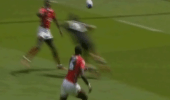
Sevens - 2 v 1
A variety of passes create a 2 v 1 which is executed perfectly for the outside attacker to score. Key factors : Different angles of running and support - Comunication - Ball presentation - Effective clearing of defenders at the breakdown - Accurate wide passes - Attack the inside shoulder of the last defender - Flat spin pass
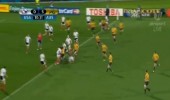 0:17
0:17
Men's - 2 v 1
A good example of phase play to create a 2 v 1 attacking platform. The initial deep pass then creates an overlap and the defender drifts to allow the attacker to run through easily.
Key factors : Quick ball at breakdown - Straight lines of running - Deep pass - straight lines of running again - Loud communication
Step 3 - Introducing the 1 v 1 Scrum
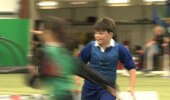 0:28
0:28
2 v 1 Draw and Pass
A basic 2 v 1 drill that encourages players to time their pass after they have drawn a defender, and for the supporting player to hold their depth.

Women's - 2 v 1
Women's - 2 v 1

Women's - 2 v 3 2

Sevens - 2 v 1 2
1. Support - 1,2,3 Follow Through
Isolated technical practice
Courtesy of the SRU
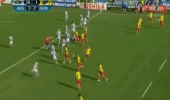 0:20
0:20
Men's - 3 v 2 2
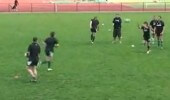
Passing 4 v 3 reset
A progression from 2 v 1 , 3 v 2 to 4 v 3
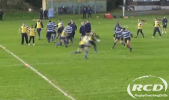 0:46
0:46
3 v 2 and then another defender
Develop decision-making skills in attack. 3 attackers must beat 2 defenders, before facing a third immediately after.
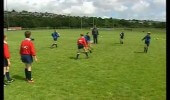 0:15
0:15
Introducing live defenders for 2 v 1
Developing passing skills with more pressure and intensity
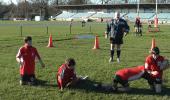 0:37
0:37
Tackling on Knees - 3 v 1
Using three attackers ensures the defender tackles on both sides and from slightly different angles. The coach can vary the pace and width of this exercise
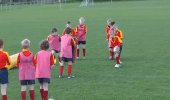 1:49
1:49
2 v 1 Passing
Adding a live defender helps to encourage players to hold their depth in support, so a good pass can be completed.
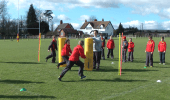 1:16
1:16
Passing - 3 v 2 Static Defenders
Progress to working in 3s against two static defenders. The pressure is on the middle player to hold their depth and perform a quick pass.
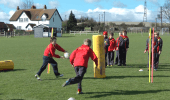 1:02
1:02
Passing - 2 v 1 Static Defender
Now working in just twos, we are concerned with depth, and the timing of the pass. Allow players to practice before adding a static defender. This can be a tackle bag as demonstrated. Players take the ball up to the defender but must complete the pass before they reach it.
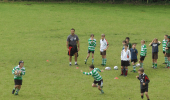 1:00
1:00
Attack 2 v 1
A good decision-making exercise which requires players to practice their basic running and passing skills
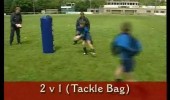
Learning to pass 2 v 1
Developing lines of running to attack the inside shoulder of defenders
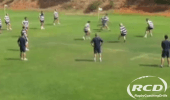 1:19
1:19
3 v 2 attacking practice
A useful drill to build decision-making skills. Attackers must choose from a variety of running and passing options.
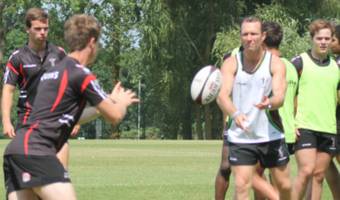 3:05
3:05
3 v 2 How to Fix Defenders
Running straight & fixing defenders is a skill that all players must learn and learn at an early age. The top players regularly practise this skill to maintain accuracy. This is the building block to scoring tries
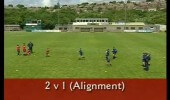 0:15
0:15
2 v 1 with withd & flat pass
These are core skill drills for youngsters to learn the game. As a coach you can alter the width and depth of the supporting players
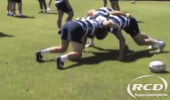 0:53
0:53
Scrum Technique 1 v 2
This drill acts as a warm up for the single player, with the other two simply providing resistance. The single player must maintain a strong body position and push the other two backwards.
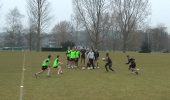 2:59
2:59
Quins Defence - 2 v 2 tackling
A progression from the 1 v 1 drill this exercise adds extra players to make the decision making process more realistic. The coaches can vary the delivery of the ball and the width of the area to put different conditions to the players
11. 6 v 2 v 2 v 2
Step 4 - Introducing the 2 v 2 Scrum
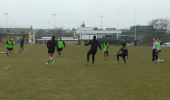 2:59
2:59
Quins Defence - Tackling in units 3 v 3
This exercise is part of a tackle technique progression and pitches 3 attackers v 3 defenders. As in match play the attacking players will present different challenges to the defenders. The coaches can choose to alter the conditions to put more or less pressure on the players
Step 5 - Introducing the 3 v 3 Scrum
 1:32
1:32
Quins Defence - 1 v 1 tackle skills
Close contact in a small channel ensures the players work their movement skills in both attack and defence. The coach reinforces the skills for contact prior to progressing this exercise
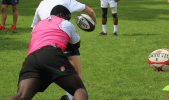 2:54
2:54
Quins - Tackle Technique 1 v 1
A new tackle technique exercise without the "Bone on Bone" collisions
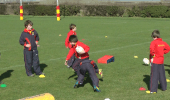 2:24
2:24
1 v 1 Tackling in Channel
An opportunity for players to put what they have learnt on tackle technique into practice. Each tackle is observed by all other players who can give feedback. Ensure all players have a go at attacking and defending.
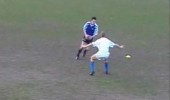 0:07
0:07
1 v 1 defence
Winger positional skills.
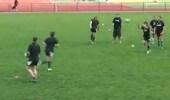 0:14
0:14
Evasion 1 v 1 after pass
Core skills handling
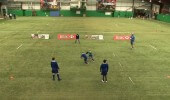 0:38
0:38
1 v 1 Evasion Skills
A lone attacker must beat a single defender. This is great way to develop evasion skills in the attacker, and positioning for the defender.
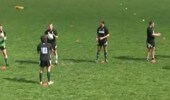 0:14
0:14
Evasion 1 v 1
A decision making exercise to beat defenders and attack shoulders
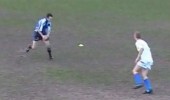
1 v 1 attack
Winger positional skills training.
 0:18
0:18
Junior - Exiting the 22m 1
Junior - Exiting the 22m 1
 0:30
0:30
Junior - Good contact body position/ball presentation 1
Junior - Good contact body position/ball presentation 1
 0:20
0:20
Junior - Wrap Tackle 2
Junior - Wrap Tackle 2
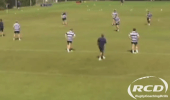 0:51
0:51
Attacking progression's 4 v 3
A progression from 3 v 2s, this drill is closer to a game situation, where there are more decisions for the attacking players to make. The gaps could appear in a variety of locations and they have several passing /running options. With 4 attacking players, you may wish to utilise your basic strike moves.
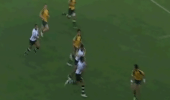 0:21
0:21
Junior - Strike Moves 1
Junior - Strike Moves 1
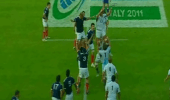 0:17
0:17
Junior - Ball off the top from lineout 2
Junior - Ball off the top from lineout 2
Level 2 - Back Row Example Clip 1
Level 2 - Back Row Example Clip 1
 0:42
0:42
Junior - Accurate clearing of players 1
Junior - Accurate clearing of players
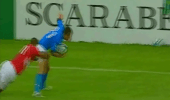
Junior - Classic Tackle 1
Level 2 - Back Row Example Clip 3
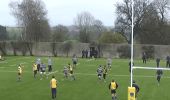 1:00
1:00
Attack Grid - 4 v 2
This continuous exercise puts pressure on your players to think fast and be ruthless in attacking the space. Coaches can change the size of the grid and the number of defenders to make it an easier game
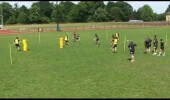 0:54
0:54
Change the point of attack - 4 v 3
This drill allows you to develop decision making by varying the attack and defence continually thus accelerating learning
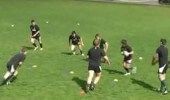
4 v 3 after 5m reset
Core skills training
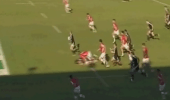
Junior - Continuity of play 1
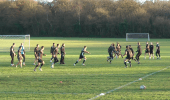 1:43
1:43
Broncos 4 - 6 v 3 Identify space
Players to attack with "Heads up" and identify where colleagues have space. Supporting players to call early to the ball carriers. Defenders to stay tight to not let attack through the middle spaces easily
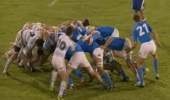
Junior - Wheeled Scrums 1
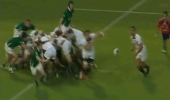
Junior - Wheeled Scrums 2
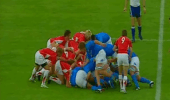
Junior - Collapsed Scrums 1
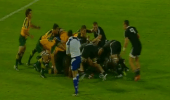
Junior - Collapsed Scrums 2
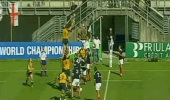
Junior - Full Lineout 1
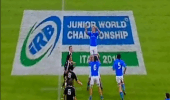
Junior - Full Lineout 2
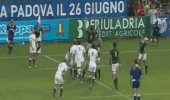
Junior - Short Lineout 1
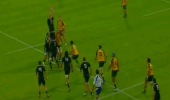
Junior - Short Lineout 2
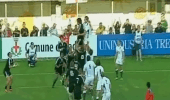
Junior - Ball off the top from lineout 1

Junior - Standard restart with attack winning ball 1

Junior - Standard restart with attack winning ball 2

Junior - Exiting the 22m 2

Junior - Patterns of Play 1

Junior - Strike Moves 2
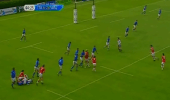
Junior - Patterns of Play 2

Junior - Classic Tackle 2

Junior - Classic Tackle 3

Junior - Wrap Tackle 1

Junior - Good contact body position/ball presentation 2

Junior - Good contact body position/ball presentation 3

Junior - Leg Drive 1

Junior - Leg Drive 2

Junior - Support player / Leach 1

Junior - Support player / Leach 2

Junior - Accurate clearing of players 2
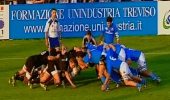 0:23
0:23
Junior - Straight Scrums 2
Two even packs compete at the scrum, good technique creates a good and safe contest. The black team use the platform from the scrum to score a try wide out. Key factors : 8 players working as a unit - Calling - Strong body position - Hips, back and head all facing forward - Accurate binding

Junior - Continuity of play 2
11. 4 v 2 Continuous Touch Rugby
Small -sided game - 5 v 3
This is an intuitive decision-making pratice
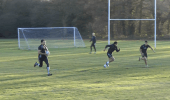 0:49
0:49
Broncos 1 - Scramble defence - Tracking back
Use this exercise to replicate a line break with one defender to beat. The attackers need to move the defender and execute a 2 v 1 while the initial defender tracks back to stop the pass. Also works movement at top end speed for the main attacker
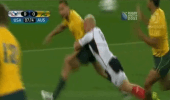 0:15
0:15
Men's - Offloads 2
A counter attack invlving moving the ball wide quickly, then attack defenders with support runners and finally a 2 v 1 to score in the corner. Key factors : Strong communication - Wide spin passes - Attacking the space around defenders - Support the ball carrier from behind - Offload with two hands - straight running - Flat pass
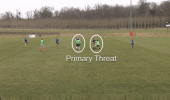
Defence - 1. Primary Threat
If the ball is tucked under one arm, the ball carrier is unlikely to throw a 10 metre miss pass. So are the attackers 2 and 3 places out the primary threat?
If the ball carrier is running with the ball in both hands, the immediate threat may have a wider radius
If two centres are running at a centre and a prop, the primary threat may be the space defended by the prop
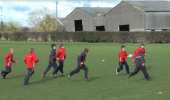 2:28
2:28
Conditioned Touch - Linked defenders
In this game, two defenders must link up, slowing them down and creating more opportunities for the attacking side. This can create the overlap necessary to put 2 v 1 and 3 v 2 techniques into practice.
Step 2 - Introducing Competition for the Ball
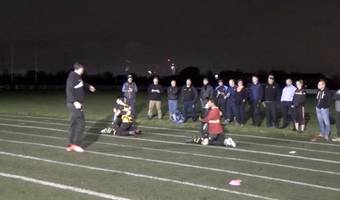 3:46
3:46
Functional Movement Warm Up Part 2
Every player should be able to perform these movements well! Mastering these will carry over to preventing injuries, managing collisions and maximising power and speed. Check out the related videos for part 1.
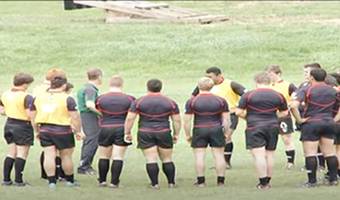 2:16
2:16
L2 - Outflanking Game
Skill Practice Description The objective of this game is to develop the ability to execute the 2 v 1 with consistent efficiency. • The attacking team initially has at least one extra players in order to create an advantage. • There is a channel on each wing in which only 1 defender and 2 attackers may enter at any time. • The attack works the play to get the ball into the outside channel then execute the 2 v 1. • With the extra players, the attack can also develop opportunities to penetrate the defence and so the game in not relying on lateral moment and still incorporates the principles of ‘go forward’. • The progression is to remove the cones and see if the players can still take advantage of the 2 v 1 without the conditions set within the channelled areas . • A further progression would be to even the numbers of each team. Key Coaching Points • Running lines to condense and hold defences in order to outflank. • Running lines in order to disrupt and penetrate the defence line. Relevance to the Game • Attacking players often fail to fix defenders effectively and may drift or over elaborate. • This game will assist in angles of run that fix the last defender
2-man Tackle and Decision-making
This practice develops communication in a three v three game format

